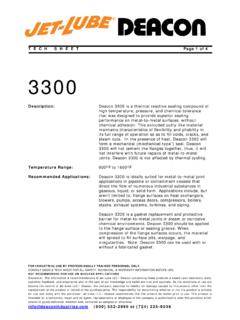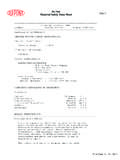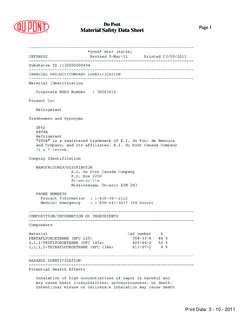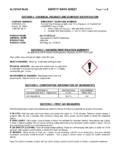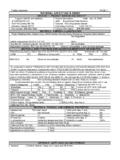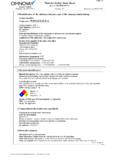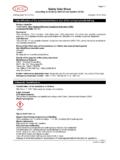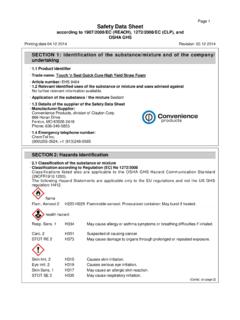Transcription of SAFETY DATA SHEET Page 1 of 5
1 SAFETY data SHEET Page 1 of 5. Date Prepared: February 1, 2017. 1. Product and Company Identification Jet-Lube LLC / Deacon Bldg. #1, West Point Drive Washington, PA 15301 USA. Phone (724) 225-8008. 24 Hour Emergency Response Contact: CHEMTREC (USA and CANADA). Phone: 800-424-9300 or 703-527-3887. Product Name: Deacon 770-L. Product Type: Sealant Compound Product Description: Brown Liquid General Use : Sealant Liquid 2. Hazards Identification GHS Classification : Carcinogenicity, 1A. Skin Irritation, 2. Eye Irritation, 2B. Aspiration Hazard, 1. GHS Label Elements : Signal Word : Warning Hazard Statements: H315 / 320 Causes Skin and Eye Irritation H333 May be harmful if inhaled (respirable dust, see NOTE below). H303 May be harmful if swallowed H335 May cause respiratory irritation Precautionary Statements : P261 Avoid breathing dust/vapors P262 Do not get in eyes, on skin, or on clothing P285 In case of inadequate ventilation wear respiratory protection P281 Use personal protective equipment as required P301/P330/P331 If Swallowed : Rinse mouth, Do NOT induce vomiting.
2 P301/P310 If Swallowed: Immediately call a Poison Center or Physician P333/P313 If skin irritation or rash develops: Get medical attention. P302/P352 If on skin: Wash with plenty of soap and water P305/P351/P338 If in eyes : Rinse cautiously with water for several minutes. Remove contact lenses if easy to do. Continue Rinsing. P337/P313 If eye irritation persists: Get medical attention P342/P311 If experiencing respiratory symptoms : Get medical attention. P233 Keep container tightly closed P210 Keep away from open flames. No Smoking P501 Dispose of observing all Federal, State and Local regulations. NOTE: THIS PRODUCT IN ITS PURCHASED FORM DOES NOT PRESENT AN. INHALATION HAZARD FROM FIBERS OR DUST, AS IT IS A LIQUID. DUST IS NOT AIRBORN UNDER NORMAL HANDLING. SDS Product Name: Deacon 770-L Page 2 of 5. 3. Composition / Information on Ingredients Ingredients CAS No.
3 % by weight Solvent Mixture 64742-47-8 1-20. Crystalline Silica None <2. Modified Natural Resins Proprietary 75-100. 4. First Aid Measures Ingestion: DO NOT INGEST. Oral toxicity not determined. Do NOT induce vomiting. Even small amount of solvent aspirated into the lungs during ingestion or vomiting may cause aspiration pneumonitis. If vomiting occurs spontaneously, keep head below hips to prevent aspiration Call a physician or get medical help immediately. Inhalation: Remove to fresh air. If symptoms persist, seek medical attention. Skin Contact: Wash with soap and water, consult physician if rash develops. Eye Contact: Flush with water 15 minutes. If symptoms persist, seek medical attention. 5. Fire Fighting Measures Recommended Extinguishing Agent: Foam, Dry Chemical, Carbon Dioxide, Water Fog Special Fire Fighting Procedures: Self contained breathing apparatus and protective clothing should be worn in fighting fires involving chemicals.
4 (Professionally Trained Personnel). Hazardous Products Formed by Fire or Thermal Decomposition: CO, CO2, H2S, SO2, Smoke, Incomplete Combustion Products Unusual Fire or Explosion Hazards: Closed containers may rupture when exposed to extreme heat or fire conditions Compressed Gases: None Pressure at Room Temperature: Does not apply 6. Accidental Release Measures Steps to be taken in cases of spill or leak: Wear proper personal protective equipment. Remove any sources of ignition from the area and allow hot surfaces to cool. Return uncontaminated material to metal container and seal container tightly. Dispose of contaminated material or waste. Clean up with mineral spirits. 7. Handling and Storage Storage: Cool, dry, storage below 90 degrees F. Store in closed containers. Refrigerate for best shelf life. Handling: Avoid contact with skin and eyes.
5 Do not breathe vapors. This product in its purchased form does not create an inhalation hazard from fibers or dust. If grinding or sanding or any other process is performed to this compound will cause airborne particles wear appropriate respirator to avoid breathing any dust or vapors. Wear appropriate SAFETY gear as required in work area. SDS Product Name: Deacon 770-L Page 3 of 5. 8. Exposure Controls / Personal Protection Exposure Limits ACGIH OSHA OTHER. Ingredients (TLV) (PEL). Crystalline Silica Cristobalite mg/m3 (respirable) mg/m3 (respirable). Tridymite mg/m3 (respirable). Quartz mg/m3 (respirable) mg/m3 (respirable). Solvent Mixture 100ppm TWA 500ppm TWA. Modified Natural Resins 10mg/m3 15mg/m3. Personal Protective Equipment (PPE). Eyes: SAFETY Glasses Skin: Chemical resistant gloves such as impervious butyl or nitrile rubber gloves.
6 Respiratory Protection: NIOSH approved for organic vapors and dust. Other Protective Clothing or Equipment: Coveralls or other protective clothing. SAFETY equipment as required in area. Work / Hygienic Practices: Avoid contact with skin. Wash hands before eating. Engineering Controls : Ventilation: Local exhaust if poorly ventilated area or in confined spaces. Ventilation should be provided during heat up to exhaust organic vapors resulting from vaporization of certain organic agents 9. Chemical and Physical Properties Appearance: Brown Liquid Odor: Solvent like pH: Solubility in Water: NIL. Specific Gravity: (uncured) (H2O =1). Evaporation Rate: Not Applicable Boiling Point: Not Applicable Melting Point: Not Applicable Vapor Pressure: Solvent only, mixture not tested : kPa ( mm Hg) at 20 C. Vapor Density: Solvent only, mixture not tested (air =1).
7 VOC Content: Max 14% by weight Flash Point: 1600 F. Method: ASTM D93 Pensky-Martens Closed Cup Flammable Limits: LEL: Not Established UEL: Not Established 10. Stability and Reactivity Stability: Stable Hazardous Polymerization: Will not occur Hazardous Decomposition Or By-Products: CO, CO2, H2S, SO2, Smoke, Incomplete Combustion Products Incompatibility: Strong Oxidizers and Strong Acids, Mineral Acids, Alkalies, SDS Product Name: Deacon 770-L Page 4 of 5. 11. Toxicology Information Primary Routes of Entry: Inhalation and contact. Signs and Symptoms of Overexposure: Inhalation: Possible dizziness or headaches, respiratory irritation. Eyes: Redness and irritation. Skin: Chemical dermatitis, redness and itching. Existing Conditions Aggravated by Exposure: Pre-existing skin condition if prolonged exposure to skin. (Wear chemical resistant gloves) Respiratory disorders, asthma, chronic emphysema, heart condition (if prolonged and continuous exposure to dust or vapors).
8 Dust exposure is not a hazard with this product under normal use. Product is in a liquid form. (Organic vapors , Wear recommended respirator if exceeding permissible exposure limit, see section 8). Carcinogenicity NTP: Crystalline Silica (respirable size) Known to be a Carcinogen IARC: Crystalline Silica, Group 1 IARC. OSHA Regulated: NO. Toxicity : (Solvent only, mixture not tested). Inhalation (Solvent): Low Toxicity: LC50 greater than near-saturated vapor concentration / 1 hour rat Skin (Solvent): Expected to be of Low Toxicity : mg/kg, Rat mg/kg, rat Ingestion: (Solvent): Expected to be of Low Toxicity : LD50>2000 mg/kg, rat Acute Health Hazards: Skin: Contact on bare skin can cause chemical dermatitis, redness, itching Inhalation: Breathing excessive vapors may cause dizziness or headaches irritation of eyes, nose, throat, lungs and can cause central nervous system depression.
9 Chronic Health Hazards: Inhalation: Crystalline Silica, respirable size NTP Known Carcinogen. Repeated exposure to solvent vapors above recommended exposure limits, can cause central nervous system effects, drowsiness, dizziness and headaches. (Wear recommended respirator if exceeding permissible exposure limit, see section 8). NOTE: THIS PRODUCT IN ITS PURCHASED FORM DOES NOT PRESENT AN. INHALATION HAZARD FROM FIBERS OR DUST, AS IT IS A LIQUID. DUST IS NOT AIRBORN UNDER NORMAL HANDLING. 12. Ecological Information Solvent Only : Expected to have low toxicity. LC/EC/IC50 > 1000 mg/l, Fish, Aquatic Invertebrates, Algae, Microorganisms. Mobility - Absorbs to soil and has low mobility. Floats on water. 13. Disposal Considerations Recommended Methods of Disposal: RCRA 40 CFR 261 Classification : This product as purchased does not fall under current US EPA RCRA.
10 Definitions of Hazardous Waste. Contains solvent, do not let waste contaminate soil or water. Certain state regulations could affect whether a material is considered a hazardous waste upon disposal. It must also be noted that a material can become a hazardous waste if it is mixed with or comes in contact with a hazardous substance during use. Under RCRA it is the responsibility of user of a product to determine at the time of disposal, whether a material should be classified as a hazardous waste. 14. Transport Information DOT (49 CFR 172): Not Regulated*. *Not Regulated under 49 CFR if in a container of 119 gallon capacity or less. IATA : Not Regulated Liquid / Solid (per ASTM D 4359-90) : Material is a liquid SDS Product Name: Deacon 770-L Page 5 of 5. 15. REGULATORY INFORMATION. CERCLA HAZARDOUS SUBSTANCES (40 CFR Part ): This product is not reportable under 40 CFR Part SARA TITLE III SECTION 302 EXTREMELY HAZARDOUS SUBSTANCES (40 CFR Part 355): This product does not contain any SARA 302 Extremely Hazardous Substances.
